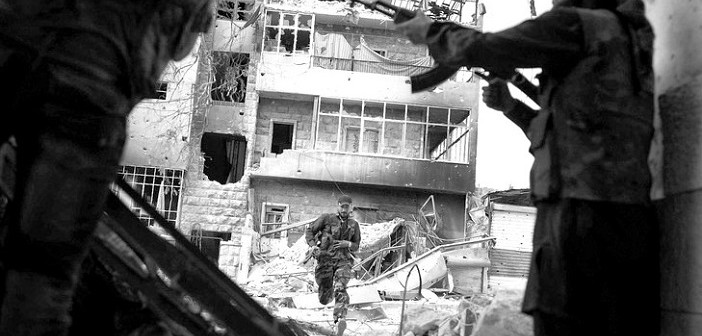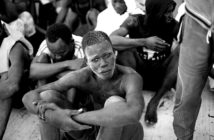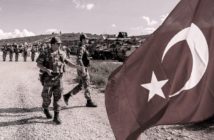Has the Free Syrian Army (FSA) lost the Battle of Aleppo… and the war?
That is the question posed at the moment, suddenly, to all those who only focused on Daesh since the first terror attacks of Paris and who have lost sight of the battle of Aleppo – the last bastion of this Free Syrian Army, the only really democratic actor in the Syrian conflict.
The Free Syrian Army appeared for the first time in Homs, at the end of 2011. The international media presented the Syrian revolution as a pacifist movement of an entire people demonstrating to change the regime. On the field, things were different: armed groups had formed very quickly, mainly in Homs, where the Sunni areas rose up against the Alawi areas that had remained loyal to the government of Bashar al-Assad. It is in this city, in which the first groups appeared, that claimed clearly to be part of a Free Syrian Army, interdenominational and democratic.
As of spring 2012 the demonstrations amplified and the regime refused to give way, preferring to respond to the uprising with violence. Self-defence groups were formed in the Sunni areas of several big and small cities. They were constituted of ordinary citizens, armed with meagre means to defend themselves from the repression of the police and the military.
The dictatorship used the army to maintain its control over the country and tried to play out the citizens against one another depending on their original governorates: the militaries from Deir ez-Zor were sent to open fire onto the demonstrators of Deraa; those from Deraa were sent to Hama, and so on. But the system rapidly showed its limits. The conscripts were not naïve and many of them began to desert, some decided to hide, but many to join armed groups, hostile to the regime. Soon after, the footmen were followed by the officers; and they began to organise and to structure the armed opposition against the dictatorship – by the summer of 2012, a Free Syrian Army already existed in all the big cities of the country, with centralised command units in each governorate, which later on would constitute a common command headquarter for the whole of Syria.
This democratic and secular force has not received any serious support. Already towards the end of 2012, it found itself facing other factions of the revolution that was transforming into a civil war, amongst which hundreds of Islamist factions, notably Jabhat al-Nosra, financed by the Gulf monarchies. A number of fighters of the Free Syrian Army abandoned their brigades to go and fight with the Islamists; less due to religious motivations, but because the Islamists had the military and logistical means to wage war, which was not the case of the Free Syrian Army.
It was the beginning of another war, in which the democrats of the FSA would play an increasingly less important role.
Confronted to this reality, several commanders of the FSA entirely abandoned the revolutionary ideal and became mobsters, ransoming the populations and living as bandits. Others disputed authority over one or the other region, leading to internal quarrels and even battles. Facing disintegration of the FSA and the tensions between the leaders, some commanders decided to accept alliances with the Islamist factions; they left the common command unit of the FSA and, at the end of 2013, formed the Syrian Revolutionary Front (mainly present in the south of Syria, in the region of Deraa). Moreover, the FSA lost its positions in the governorate of Idlib, its second-largest bastion, where it was replaced by the Liberation Army of Idlib – a merger of former FSA leaders and of Jabhat al-Nosra. In the north of Syria, several brigades formed alliances with the Kurds to form the Syrian Democratic Forces in May of 2015.
The Free Syrian Army is hence only implanted in the governorate of Aleppo, whose north and west it controls and where it fights the Islamists of Jabhat al-Nosra, the Islamic State (appeared in the region in June 2013), and the forces of the regime that hold the north-western half of the city of Aleppo.
Since September 2015, the regime, supported by Russian involvement in Syria, has progressed towards Aleppo; in February 2016, it pushed back the FSA towards the north of the governorate and has nearly entirely laid siege to the rebel’s areas of the city – which are about to fall or to endure a brutal urban war. Since some weeks, those civilians that have been able to flee Aleppo before the roads were blocked, are amassing at the Turkish border, which remains hopelessly closed…
In an attempt to remedy the situation, the FSA leaders have constituted a new military council in the northern besieged countryside of Aleppo.
This new military council denied the existence of any element of the Islamic State, the al-Nosra front or any other terrorist organizations in the besieged countryside north of Aleppo, which has been suffering from the blockade after the road linking it to the city of Aleppo was closed.
In its message, the military council affirms that the northern countryside is under the full control of the Free Syrian Army, also denying any truce with ISIS.It also denounces the attitude of the Kurdish brigades (PKK/YPG), that seem to have made agreements with the regime and are now attacking the positions of the FSA, as well as those of the Islamic State to take control of more territory.
It seems like tension is rising within the Syrian Democratic Forces; the new council called their fighters to join them and to help the FSA “to save civilians from disaster and displacement”.
Today, the FSA and the northern countryside of Aleppo suffer from a drain on three battle fronts: the western front, with Kurdish forces (PKK/YPG); thesouthern front, with al-Assad’s army and Hezbollah brigades; and the eastern front, where ISIS is trying to conquer some villages, taking advantage of the intense Russian bombardment on FSA areas.
Meanwhile, it is difficult to know exactly who are the leaders of this recomposed FSA. We do not have any trustworthy information about the number of fighters that this new command unit was able to assemble. But estimations on the field leave little doubt about the capacities of this remainder of the Free Syrian Army…






1 Comment
There is a problem with the FSA. From the beginning it was not unified and from the beginning there were islamists factions within the FSA.
From the beginning the FSA was, for the most part, anti kurd and the SNC, the political arm, was antikurd as well, stating it wanted the kurds not to have any rights, upon which the kurds did not join the FSA.
From the beginning the FSA joined islamist faction in attacking kurds and was in 2013 by the UN condemmed for the ethnic cleansing of kurdish areas.
The FSA participated from time to time in the siege of kurdish Afrin and kurdish quarters within Aleppo.
Until recently the kurds, in the SDF, were not strong enough to do anything against the FSA and JAN except for defense.
As of october several secular FSA groups were so mad about islamists within FSA that they joined the SDF, upon which the FSA and JAN started to attack them in northern Aleppo.
This, in combination with RuAF attacks on JAN and allies, among which several factions of FSA, gave the SDF the opportunity to start ending the attacks on them and to drive the islamist factions of FSA and JAN away.
Because of the heavy and direct support of Turkey and KSA, supporting islamist terror groups as long as anti Assad and or anti kurd, there are still a few FSA and JAN pockets in northern Aleppo countryside.
Strategically they are terminally defeated in the north of Syria, unless Turkey starts to pour in its army directly.
Aleppo, cut of from Turkey from the north and almost from the west, is isolated and will be conquered, the more so now the SDF has closed the supply route to the center of Aleppo.
Peace talks should start now and secular forces should reign a federated Syria. All islamist factions should either be destroyed or disbanded.